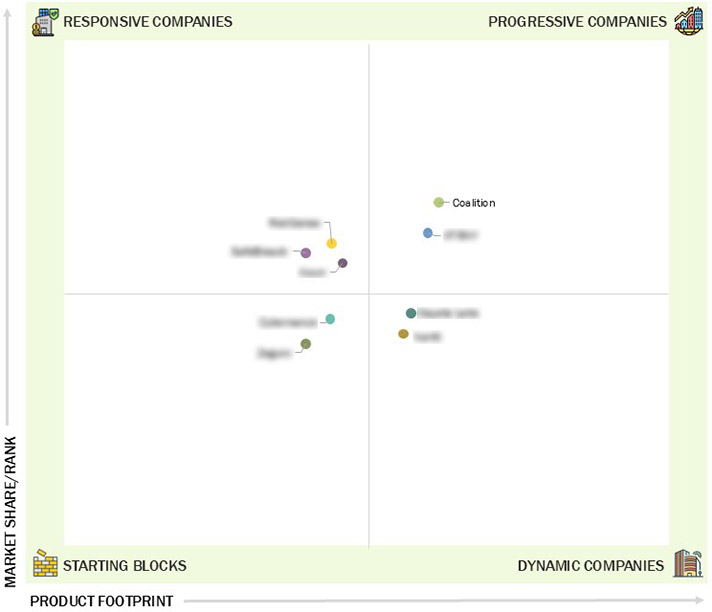Comparing 9 vendors in Cybersecurity Insurance Startups across 0 criteria.
The cybersecurity insurance market is evolving into a strategic pillar of enterprise risk management, driven by rising cyber threats and regulatory pressures. Organizations are increasingly adopting policies that cover both internal damages and external liabilities. Insurers are integrating advanced technologies to refine risk modeling and underwriting. While demand grows among small and medium enterprises, challenges persist around data scarcity, standardization, and awareness. The market is maturing through collaborations between insurers and cybersecurity firms, offering proactive services beyond financial protection.
Market Leadership Quadrant
1.1 Study Objectives
1.2 Market Definition
1.2.1 Inclusions & Exclusions
1.3 Market Scope
1.3.1 Market Segmentation
1.3.2 Years Considered
1.4 Currency Considered
1.5 Summary of Changes
1.6 Stakeholders
2.1 Introduction
2.2 Market Dynamics
2.2.1 Drivers
2.2.1.1 Surge in mandatory cybersecurity regulations and
legislations to boost demand for insurance protection
2.2.1.2 High rate of recovery of financial losses to promote
cybersecurity insurance market growth
2.2.1.3 Increase in frequency and sophistication of cyber threats
2.2.2 Restraints
2.2.2.1 Lack of awareness related to cybersecurity insurance and
reluctance in choosing cybersecurity insurance over
cybersecurity solutions
2.2.2.2 Soaring cybersecurity insurance costs
2.2.3 Opportunities
2.2.3.1 Exclusion of cybersecurity insurance cover from Property and
Casualty (P&C) insurance
2.2.3.2 Adoption of artificial intelligence and blockchain
technology for risk analytics
2.2.4 Challenges
2.2.4.1 Cyber insurers grapple to gain traction despite soaring
cybersecurity risks
2.2.4.2 Data privacy concerns
2.2.4.3 Lack of understanding, technical knowledge, and absence of
historical cyber data for effective underwriting
2.3 Industry Trends
2.3.1 Supply Chain Analysis
2.3.2 Ecosystem
2.3.3 Tools, Techniques, and Frameworks in Cybersecurity Insurance
Market
2.3.4 Current and Emerging Business Models
2.3.5 Porter’s Five Forces Model
2.3.5.1 Threat of new entrants
2.3.5.2 Threat of substitutes
2.3.5.3 Bargaining power of suppliers
2.3.5.4 Bargaining power of buyers
2.3.5.5 Intensity of competitive rivalry
2.3.6 Technology Analysis
2.3.6.1 Key technologies
2.3.6.1.1 Artificial Intelligence and Machine Learning
2.3.6.1.2 Big Data Analytics
2.3.6.1.3 Internet of Things
2.3.6.2 Adjacent technologies
2.3.6.2.1 Blockchain
2.3.6.2.2 Cloud
2.3.6.3 Complementary technologies
2.3.6.3.1 Threat Intelligence
2.3.6.3.2 Data Breach Response
2.3.6.3.3 Security Monitoring & Analytics
2.3.7 Future of Cybersecurity Insurance Market Landscape
2.3.7.1 Short-term roadmap (2025–2026)
2.3.7.2 Mid-term roadmap (2027–2028)
2.3.7.3 Long-term roadmap (2029–2030)
2.3.8 Trends/Disruptions Impacting Customer Business
2.3.9 Best Practices in Cybersecurity Insurance Market
2.3.10 Patent Analysis
2.3.10.1 Methodology
2.3.11 Key Conferences and Events, 2025
2.3.12 Key Compliances in Cybersecurity Insurance Market
2.3.12.1 Introduction
2.3.12.2 Healthcare Compliance
2.3.12.3 Financial Services Compliance
2.3.12.4 GDPR Compliance
2.3.12.5 Other Compliances
2.3.13 Investment and Funding Scenario
2.3.14 Introduction to Artificial Intelligence and Generative AI
2.3.14.1 Impact of generative AI on cybersecurity insurance
2.3.14.2 Use cases of generative AI in cybersecurity insurance
2.3.14.3 Future of generative AI in cybersecurity insurance
2.3.15 Impact of US Tariff – Cybersecurity Insurance Market
2.3.15.1 Introduction
2.3.15.2 Key tariff rates
2.3.15.3 Price impact analysis
2.3.15.4 Impact on country/region
2.3.15.4.1 US
2.3.15.4.2 Europe
2.3.15.4.3 Asia Pacific
2.3.15.5 Impact on cybersecurity insurance verticals
3.1 Introduction
3.2 Key Player Strategies/Right to Win, 2021-2024
3.2.1 Overview of Strategies Adopted By Key Cybersecurity Insurance
Technology Players
3.3 Revenue Analysis, 2020-2024
3.4 Market Share Analysis of Top Players
3.5 Startup/SME Evaluation Matrix, 2024
3.5.1 Progressive Companies
3.5.2 Responsive Companies
3.5.3 Dynamic Companies
3.5.4 Starting Blocks
3.5.5 Competitive Benchmarking
3.5.5.1 Detailed list of key startups/SMEs
3.5.5.2 Competitive benchmarking of key startups/SMEs
3.6 Brand/Product Comparison
3.7 Company Valuation and Financial Metrics
3.8 Competitive Scenario
3.8.1 Product Launches
3.8.2 Deals
4.1 AT-BAY
4.1.1 Business overview
4.1.2 Products/Solutions/Services offered
4.1.3 Recent developments
4.2 CYBERNANCE
4.2.1 Business overview
4.2.2 Products/Solutions/Services offered
4.2.3 Recent developments
4.3 COALITION
4.3.1 Business overview
4.3.2 Products/Solutions/Services offered
4.3.3 Recent developments
4.4 KOVRR
4.4.1 Business overview
4.4.2 Products/Solutions/Services offered
4.4.3 Recent developments
4.5 SAYATA LABS
4.5.1 Business overview
4.5.2 Products/Solutions/Services offered
4.5.3 Recent developments
4.6 ZEGURO
4.6.1 Business overview
4.6.2 Products/Solutions/Services offered
4.6.3 Recent developments
4.7 IVANTI
4.7.1 Business overview
4.7.2 Products/Solutions/Services offered
4.7.3 Recent developments
4.8 SAFEBREACH
4.8.1 Business overview
4.8.2 Products/Solutions/Services offered
4.8.3 Recent developments
4.9 ORCHESTRA GROUP
4.9.1 Business overview
4.9.2 Products/Solutions/Services offered
4.9.3 Recent developments


 Help Net Security
Help Net Security
 Jul 2025
Jul 2025

